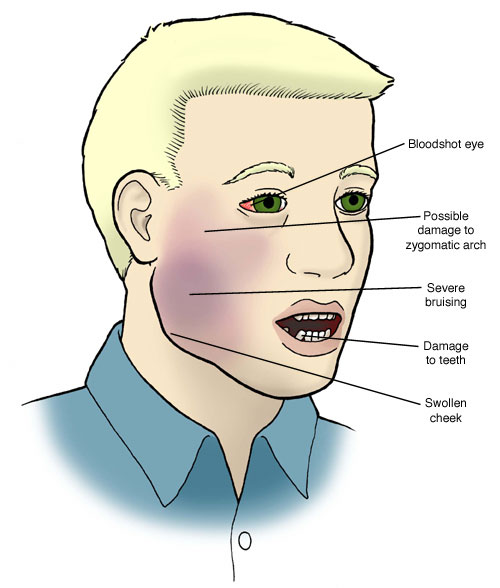

Anatomy of First Aid: A Case Study Approach
Ronald Bergman, Ph.D.
Peer Review Status: Internally Peer Reviewed
A petty officer was carrying an iron rod on his shoulder. He heard his name being called and swung around. The iron rod accidentally hit a Sailor in the face with great force. He fell to the floor and broken teeth and bloody saliva came from his mouth; he was unconscious. The face of the Sailor began to swell and extensive bruising became evident. A corpsman was called immediately.
(It is important for the person providing first-aid to know the anatomical basis of the injured region before treatment starts. This information is provided in the first illustration).

The Sailor was coughing and choking and it was not certain if there was any neck damage. The corpsman, with additional aid from other Sailors, carefully rolled the patient to his side. Particular attention was paid to the position of the head and neck so that it remained facing forward in its usual position with the body lying on its side. The Sailor's mouth was inspected and cleared of broken teeth and foreign bodies; the choking ceased. Whole teeth were wrapped in a sterile or clean cloth. The patient gradually became conscious but was in great pain, which the corpsman medicated. A neck brace was applied until the extent of the injuries could be accurately determined. The patient was turned on his side so that blood and saliva could drain from his mouth. Bleeding from a small cut on the Sailor's face was cleaned with a moist sterile cloth and controlled by gentle pressure. A cold bandage or package was applied to help reduce swelling of the tissues associated with the jaw.

The following clues were sufficient for the corpsman to diagnose a broken jaw: facial tenderness, swelling, a change in symmetry of the face, pain on moving the jaw, inability to speak and open or close the jaw. The possibility of other damage, e.g., to the zygomatic arch, the orbit and eye must also be carefully considered (second illustration).
The corpsman also determined that the airway was clear, controlled bleeding and supervised the transfer of the Sailor to sickbay for definitive medical attention.
Please send us comments by filling out our Comment Form.
All contents copyright © 1995-2024 the Author(s) and Michael P. D'Alessandro, M.D. All rights reserved.
"Anatomy Atlases", the Anatomy Atlases logo, and "A digital library of anatomy information" are all Trademarks of Michael P. D'Alessandro, M.D.
Anatomy Atlases is funded in whole by Michael P. D'Alessandro, M.D. Advertising is not accepted.
Your personal information remains confidential and is not sold, leased, or given to any third party be they reliable or not.
The information contained in Anatomy Atlases is not a substitute for the medical care and advice of your physician. There may be variations in treatment that your physician may recommend based on individual facts and circumstances.
URL: http://www.anatomyatlases.org/